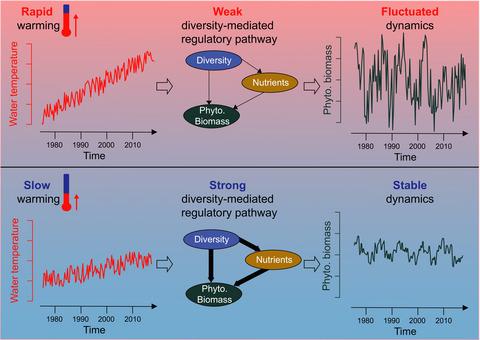当前位置:
X-MOL 学术
›
Glob. Change Biol.
›
论文详情
Our official English website, www.x-mol.net, welcomes your feedback! (Note: you will need to create a separate account there.)
Long-term warming destabilizes aquatic ecosystems through weakening biodiversity-mediated causal networks.
Global Change Biology ( IF 11.6 ) Pub Date : 2020-08-31 , DOI: 10.1111/gcb.15323 Chun-Wei Chang,Hao Ye,Takeshi Miki,Ethan R Deyle,Sami Souissi,Orlane Anneville,Rita Adrian,Yin-Ru Chiang,Satoshi Ichise,Michio Kumagai,Shin-Ichiro S Matsuzaki,Fuh-Kwo Shiah,Jiunn-Tzong Wu,Chih-Hao Hsieh,George Sugihara
Global Change Biology ( IF 11.6 ) Pub Date : 2020-08-31 , DOI: 10.1111/gcb.15323 Chun-Wei Chang,Hao Ye,Takeshi Miki,Ethan R Deyle,Sami Souissi,Orlane Anneville,Rita Adrian,Yin-Ru Chiang,Satoshi Ichise,Michio Kumagai,Shin-Ichiro S Matsuzaki,Fuh-Kwo Shiah,Jiunn-Tzong Wu,Chih-Hao Hsieh,George Sugihara

|
Understanding how ecosystems will respond to climate changes requires unravelling the network of functional responses and feedbacks among biodiversity, physicochemical environments, and productivity. These ecosystem components not only change over time but also interact with each other. Therefore, investigation of individual relationships may give limited insights into their interdependencies and limit ability to predict future ecosystem states. We address this problem by analyzing long‐term (16–39 years) time series data from 10 aquatic ecosystems and using convergent cross mapping (CCM) to quantify the causal networks linking phytoplankton species richness, biomass, and physicochemical factors. We determined that individual quantities (e.g., total species richness or nutrients) were not significant predictors of ecosystem stability (quantified as long‐term fluctuation of phytoplankton biomass); rather, the integrated causal pathway in the ecosystem network, composed of the interactions among species richness, nutrient cycling, and phytoplankton biomass, was the best predictor of stability. Furthermore, systems that experienced stronger warming over time had both weakened causal interactions and larger fluctuations. Thus, rather than thinking in terms of separate factors, a more holistic network view, that causally links species richness and the other ecosystem components, is required to understand and predict climate impacts on the temporal stability of aquatic ecosystems.
中文翻译:

长期变暖通过削弱生物多样性介导的因果网络而破坏了水生生态系统。
要了解生态系统将如何应对气候变化,就需要在生物多样性,物理化学环境和生产力之间建立功能性响应和反馈网络。这些生态系统组成部分不仅会随着时间变化,而且还会相互影响。因此,对个体关系的调查可能无法充分了解它们之间的相互依存关系,并限制了预测未来生态系统状态的能力。我们通过分析来自10个水生生态系统的长期(16-39年)时间序列数据并使用会聚交叉映射(CCM)来量化联系浮游植物物种丰富度,生物量和理化因子的因果网络,从而解决了这一问题。我们确定了单个数量(例如,物种丰富度或营养总量)不是生态系统稳定性的重要预测指标(量化为浮游植物生物量的长期波动);相反,由物种丰富度,养分循环和浮游植物生物量之间的相互作用组成的生态系统网络中的综合因果路径是最佳的稳定性预测指标。此外,随着时间的推移变暖加剧的系统既减弱了因果关系,又减弱了较大的波动。因此,为了理解和预测气候对水生生态系统时间稳定性的影响,需要一种更加整体的网络观点,而不是根据单独的因素进行思考,因为这种观点将物种丰富度与其他生态系统成分联系在一起。由物种丰富度,养分循环和浮游植物生物量之间的相互作用组成的,是稳定性的最佳预测指标。此外,随着时间的推移变暖加剧的系统既减弱了因果关系,又减弱了较大的波动。因此,为了理解和预测气候对水生生态系统时间稳定性的影响,需要一种更加整体的网络观点,而不是根据单独的因素进行思考,因为这种观点将物种丰富度与其他生态系统成分联系在一起。由物种丰富度,养分循环和浮游植物生物量之间的相互作用组成的,是稳定性的最佳预测指标。此外,随着时间的推移变暖加剧的系统既减弱了因果关系,又减弱了较大的波动。因此,为了理解和预测气候对水生生态系统时间稳定性的影响,需要一种更加整体的网络观点,而不是根据单独的因素进行思考,因为这种观点将物种丰富度与其他生态系统成分联系在一起。
更新日期:2020-10-19
中文翻译:

长期变暖通过削弱生物多样性介导的因果网络而破坏了水生生态系统。
要了解生态系统将如何应对气候变化,就需要在生物多样性,物理化学环境和生产力之间建立功能性响应和反馈网络。这些生态系统组成部分不仅会随着时间变化,而且还会相互影响。因此,对个体关系的调查可能无法充分了解它们之间的相互依存关系,并限制了预测未来生态系统状态的能力。我们通过分析来自10个水生生态系统的长期(16-39年)时间序列数据并使用会聚交叉映射(CCM)来量化联系浮游植物物种丰富度,生物量和理化因子的因果网络,从而解决了这一问题。我们确定了单个数量(例如,物种丰富度或营养总量)不是生态系统稳定性的重要预测指标(量化为浮游植物生物量的长期波动);相反,由物种丰富度,养分循环和浮游植物生物量之间的相互作用组成的生态系统网络中的综合因果路径是最佳的稳定性预测指标。此外,随着时间的推移变暖加剧的系统既减弱了因果关系,又减弱了较大的波动。因此,为了理解和预测气候对水生生态系统时间稳定性的影响,需要一种更加整体的网络观点,而不是根据单独的因素进行思考,因为这种观点将物种丰富度与其他生态系统成分联系在一起。由物种丰富度,养分循环和浮游植物生物量之间的相互作用组成的,是稳定性的最佳预测指标。此外,随着时间的推移变暖加剧的系统既减弱了因果关系,又减弱了较大的波动。因此,为了理解和预测气候对水生生态系统时间稳定性的影响,需要一种更加整体的网络观点,而不是根据单独的因素进行思考,因为这种观点将物种丰富度与其他生态系统成分联系在一起。由物种丰富度,养分循环和浮游植物生物量之间的相互作用组成的,是稳定性的最佳预测指标。此外,随着时间的推移变暖加剧的系统既减弱了因果关系,又减弱了较大的波动。因此,为了理解和预测气候对水生生态系统时间稳定性的影响,需要一种更加整体的网络观点,而不是根据单独的因素进行思考,因为这种观点将物种丰富度与其他生态系统成分联系在一起。



























 京公网安备 11010802027423号
京公网安备 11010802027423号